Review: The TRX Series, from City Theatrical and Philips Color Kinetics
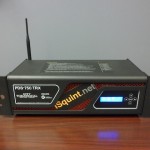 Not long ago, Philips Color Kinetics introduced the next generation of Color Blast’s: The TRX Series. Adding 2 new colors to the standard regimen of Red, Green, and Blue, these new Color Blasts called for a more intelligent power supply. Providing this new backbone is City Theatrical and the new PDS-750 TRX Power and Data Supply. Not one to rest on their laurels, City Theatrical raised the bar with this reinvention of their industry standard PDS. Lets start at the beginning:
Not long ago, Philips Color Kinetics introduced the next generation of Color Blast’s: The TRX Series. Adding 2 new colors to the standard regimen of Red, Green, and Blue, these new Color Blasts called for a more intelligent power supply. Providing this new backbone is City Theatrical and the new PDS-750 TRX Power and Data Supply. Not one to rest on their laurels, City Theatrical raised the bar with this reinvention of their industry standard PDS. Lets start at the beginning:
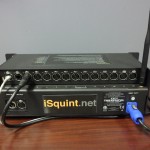 The PDS 750 TRX is housed in a very sturdy, 3U rack mount or pipe mount housing. The front panel has the factory label; a stylish, red air flow grill; and the back-lit LED display and 5 button control interface. On the top of the fixture is a welcome cheat sheet that covers basic setup in all modes. The back panel contains the PowerCon power input and fuse, the 5-Pin DMX In and Out, a USB connection for software updates, a 2-port EtherCon switch, the 12 4-Pin Fixture outputs, and the SHoW DMX wireless antenna. There is also a small hole in the metal casing, presumably for a safety cable if you are pipe mounting the PDS.
The PDS 750 TRX is housed in a very sturdy, 3U rack mount or pipe mount housing. The front panel has the factory label; a stylish, red air flow grill; and the back-lit LED display and 5 button control interface. On the top of the fixture is a welcome cheat sheet that covers basic setup in all modes. The back panel contains the PowerCon power input and fuse, the 5-Pin DMX In and Out, a USB connection for software updates, a 2-port EtherCon switch, the 12 4-Pin Fixture outputs, and the SHoW DMX wireless antenna. There is also a small hole in the metal casing, presumably for a safety cable if you are pipe mounting the PDS.
Control of PDS-750 TRX is available via wired DMX, wireless SHoW DMX, Ethernet (ArtNet, sACN, or Ki-Net) or using one of the on-board programs or static colors. Setup is quick and simple. Plug in your power cord and hook up your fixtures and then using either the on-board setup wizard or the advanced setup menus you can select your method of control. The PDS-750 TRX will run any combination of 2, 3 or 5 color CK fixtures. Using the on-board fixture patch you can actively adapt the fixture’s address’s so that there are no wasted DMX channels as in the past. A nice part about the setup wizard is that it will also identify the types of fixtures connected and ask you what control profile you want to use.
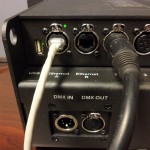 DMX control of the PDS-750 TRX is as simple as connecting a control source to the 5-pin input on the unit. In basic 8-bit mode, the fixtures operate on one channel per color, up to the full 5 colors available in the Color Blast TRX’s. Using my test console (an Elation SDC-6), the Color Blast dimmed smoothly and with a very even curve.
DMX control of the PDS-750 TRX is as simple as connecting a control source to the 5-pin input on the unit. In basic 8-bit mode, the fixtures operate on one channel per color, up to the full 5 colors available in the Color Blast TRX’s. Using my test console (an Elation SDC-6), the Color Blast dimmed smoothly and with a very even curve.
SHoW DMX control allows the PDS to operate wirelessly on any one of 16 different channels (or universes). Using the same test console connected to a standard SHoW DMX indoor transmitter, I had full control of the fixture with zero lag time despite four WiFi networks and Bluetooth scanners also running in the same environment. A feature of note when running SHoW DMX is that the DMX connector on the back of the PDS will output whatever universe the PDS is receiving. This allows you to control the rest of your DMX devices without investing in more receivers. It’s a very nice hat-tip from the folks at CTI.
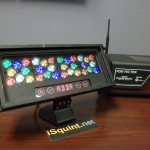 Ethernet control of the PDS was a bit more challenging, but only due to the steps needed to enter the IP address information. You can control the PDS over ArtNet, sACN (think ETCNet 3), or Ki-Net (Color Kinetics Architectural). Having the extra Ethernet port is an excellent add-on that makes daisy chaining multiple PDS units a snap.
Ethernet control of the PDS was a bit more challenging, but only due to the steps needed to enter the IP address information. You can control the PDS over ArtNet, sACN (think ETCNet 3), or Ki-Net (Color Kinetics Architectural). Having the extra Ethernet port is an excellent add-on that makes daisy chaining multiple PDS units a snap.
Not having a sACN source, I setup and configured the PDS for ArtNet control on a static IP address. I then logged into the WiFi network with my iPad and using Alcorn McBride’s LightingPad was able to control the PDS perfectly. There was no lag time and the dimming curves were as smooth as ever. CTI also gives Ethernet control the same hat-tip as SHoW DMX by outputting the same control universe to the DMX port on back.
Not to be outdone, Philips Color Kinetics has taken the next generation Color Blast TRX to the next level. Featuring not just RGB color mixing, CK added Amber and White to the mix. For theatre and Broadway applications, the soft tones that can now be mixed are a most welcome addition. The Color Blast TRX also features a first-ever 4-character LED display and touch sensitive buttons for at-fixture controls. As introduced with the TR, the TRX features both clear and frosted lenses that can be swapped out. The rubber surround is gone and in its place is a CTI accessory holder.
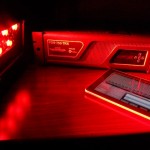 Operation of the on-board control is simple and elegant. Press the two outermost buttons at the same time and the controls unlock for about 60 seconds. You can set the DMX address, fixture profile, set static colors, chases, and run a test mode to name a few functions. The control buttons use the same type of touch sensor glass that many smart phones use. You don’t actually press them, you just tap them. One would imagine this will significantly increase fixture reliability as adding physical contactors adds a mechanical failure point.
Operation of the on-board control is simple and elegant. Press the two outermost buttons at the same time and the controls unlock for about 60 seconds. You can set the DMX address, fixture profile, set static colors, chases, and run a test mode to name a few functions. The control buttons use the same type of touch sensor glass that many smart phones use. You don’t actually press them, you just tap them. One would imagine this will significantly increase fixture reliability as adding physical contactors adds a mechanical failure point.
Overall the color mix and output of the new Color Blast TRX is excellent. However, don’t get rid of your iW Blasts just yet. The amber and white are excellent additions that allow the TRX to mix some amazing new colors. However, the white and amber only output is just not quite bright enough to be effective on its own. Overall though, Philips Color Kinetics has added an excellent new addition to the Color Blast legacy. Combined with City Theatrical’s new PDS-750 TRX, the bar has been set for ease of use and functionality.
 The new TRX technology is available now for purchase and rental from most of your top lighting dealers in the US. To round out the family, CTI also introduced the new PDS-350 TRX (6-channel vs. 12-channel). For more information please visit either City Theatrical or Color Kinetic’s websites.
The new TRX technology is available now for purchase and rental from most of your top lighting dealers in the US. To round out the family, CTI also introduced the new PDS-350 TRX (6-channel vs. 12-channel). For more information please visit either City Theatrical or Color Kinetic’s websites.
LatestHeadlines
- Upgrading Your Toolbox: City Theatrical DMXcat-E and DMXcat Multi Function Test Tool
- Claypaky Bringing Back the Sexy to Par Cans with the Midi-B FX
- Ayrton Evolves the Cobra, the Cobra2 Developed for the US Market
- MA Lighting Intros grandMA3 onPC Fader Wing and DIN-Rail Nodes
- Live Events LEVL Up Fest: A Festival to Aid our Industry